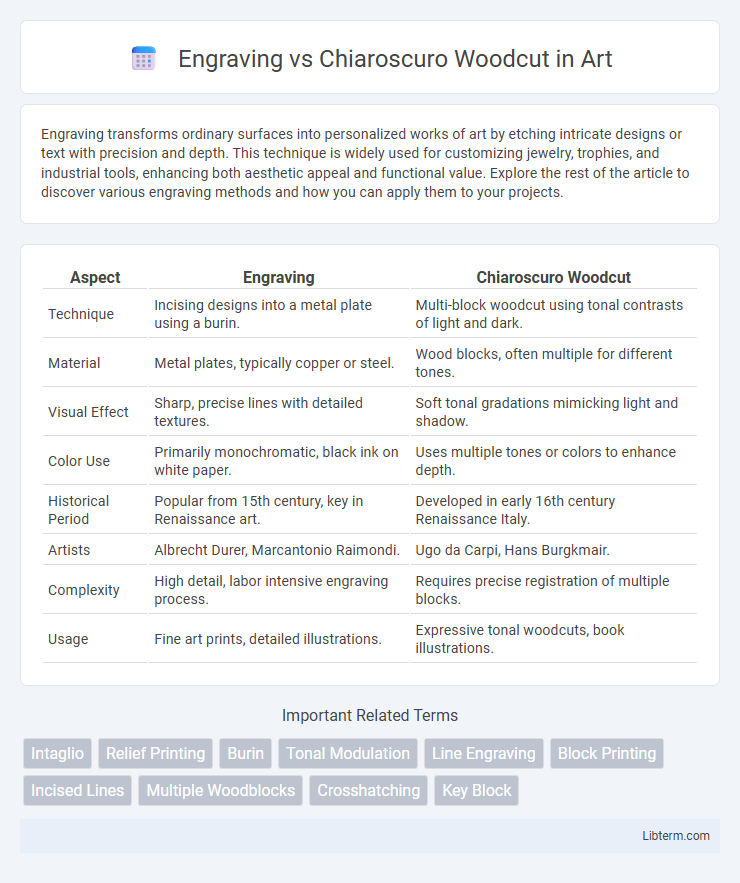Engraving transforms ordinary surfaces into personalized works of art by etching intricate designs or text with precision and depth. This technique is widely used for customizing jewelry, trophies, and industrial tools, enhancing both aesthetic appeal and functional value. Explore the rest of the article to discover various engraving methods and how you can apply them to your projects.
Table of Comparison
| Aspect | Engraving | Chiaroscuro Woodcut |
|---|---|---|
| Technique | Incising designs into a metal plate using a burin. | Multi-block woodcut using tonal contrasts of light and dark. |
| Material | Metal plates, typically copper or steel. | Wood blocks, often multiple for different tones. |
| Visual Effect | Sharp, precise lines with detailed textures. | Soft tonal gradations mimicking light and shadow. |
| Color Use | Primarily monochromatic, black ink on white paper. | Uses multiple tones or colors to enhance depth. |
| Historical Period | Popular from 15th century, key in Renaissance art. | Developed in early 16th century Renaissance Italy. |
| Artists | Albrecht Durer, Marcantonio Raimondi. | Ugo da Carpi, Hans Burgkmair. |
| Complexity | High detail, labor intensive engraving process. | Requires precise registration of multiple blocks. |
| Usage | Fine art prints, detailed illustrations. | Expressive tonal woodcuts, book illustrations. |
Introduction to Engraving and Chiaroscuro Woodcut
Engraving involves carving fine lines directly into a metal plate using a burin, creating detailed and precise images through ink transferred onto paper. Chiaroscuro woodcut uses multiple woodblocks inked with varying tones to produce images with contrasting light and shadow effects, enhancing depth and dimensionality. Both techniques represent fundamental methods in printmaking but differ in materials, tonal range, and visual impact.
Historical Origins and Development
Engraving originated in the early 15th century as a printmaking technique using metal plates, with Albrecht Durer pioneering its intricate line work during the Northern Renaissance. Chiaroscuro woodcut developed later in the 16th century, primarily in Italy and Germany, employing multiple woodblocks to achieve tonal contrasts and depth, influenced by the chiaroscuro painting technique. Both methods evolved to enhance visual storytelling, with engraving emphasizing fine detail and chiaroscuro woodcut focusing on light and shadow interplay.
Techniques and Processes Compared
Engraving involves incising precise lines onto a metal plate using a burin, allowing for fine detail and smooth tonal variation through line density and cross-hatching. Chiaroscuro woodcut employs multiple woodblocks inked in varying shades to create dramatic light and shadow contrasts, relying on layered color application rather than linear engraving. While engraving relies on intaglio techniques to create depth through line work, chiaroscuro woodcut uses relief printing with distinct tonal layers to achieve a painterly effect.
Materials Used in Both Art Forms
Engraving primarily utilizes metal plates such as copper or zinc, which are meticulously incised with sharp tools to create detailed designs. Chiaroscuro woodcut involves multiple wooden blocks, typically made from hardwoods like pear or cherry, each block inked separately to produce tonal variations and depth. The choice of metal for engraving allows for fine lines and precision, while the layered wooden blocks in chiaroscuro woodcuts enable rich contrasts between light and shadow.
Key Artists and Masterpieces
Engraving, prominently advanced by Albrecht Durer with masterpieces like "Melencolia I," showcases precise line work and detailed texture through incised metal plates. Chiaroscuro woodcut, innovated by artists such as Ugo da Carpi and later refined by Hans Burgkmair Sr., employs multiple wood blocks to achieve tonal contrasts, exemplified in Carpi's rendition of "The Young Man with a Glove." Both techniques represent pivotal methods in printmaking, distinguished by their approach to light, shadow, and line quality.
Visual Effects and Aesthetic Differences
Engraving produces precise, sharp lines that create detailed textures and high-contrast images with a polished, refined appearance. Chiaroscuro woodcut uses multiple blocks with varying tones to achieve rich, layered gradients and a dramatic interplay of light and shadow, enhancing depth and dimensionality. The engraving's linear clarity contrasts with the chiaroscuro woodcut's painterly softness, resulting in distinct visual aesthetics suited for intricate detail versus tonal richness.
The Role of Light and Shadow
Engraving employs precise incisions to manipulate light and shadow through varying line depth and spacing, creating detailed tonal contrasts that enhance texture and dimension. Chiaroscuro woodcut combines multiple woodblocks inked in different tones, using layered light and shadow to achieve dramatic depth and volumetric effects in images. Both techniques exploit the interplay of illumination and darkness but through distinct methods of carving and inking to evoke visual intensity.
Applications in Art and Printmaking
Engraving, characterized by precise lines incised into metal plates, is widely used for detailed portraits, maps, and fine art prints requiring sharp, clean images. Chiaroscuro woodcut, utilizing multiple blocks and tonal contrasts, excels in creating depth and shading effects, making it ideal for reproducing paintings and dramatic visual narratives. Both techniques enable distinct artistic expressions in printmaking, with engraving emphasizing linear detail and chiaroscuro woodcut enhancing tonal richness.
Preservation and Collectibility
Engraving offers fine, precise lines that resist wear over time, making preserved prints highly valued by collectors for their clarity and detail. Chiaroscuro woodcut, characterized by its layered tones and contrasts, often faces fragility due to the woodblocks' vulnerability, impacting long-term preservation but appealing for its unique aesthetic and rarity. Collectibility of engraving is driven by durability and historical significance, while chiaroscuro woodcuts attract enthusiasts seeking distinct tonal effects and scarcity in the print market.
Conclusion: Choosing Between Engraving and Chiaroscuro Woodcut
Engraving offers precise, detailed line work suitable for intricate designs and fine textures, while chiaroscuro woodcut emphasizes tonal contrasts through multi-layered printing, creating depth and richness in shading. The choice depends on the desired artistic effect: engraving excels in clarity and linear detail, whereas chiaroscuro woodcut provides a more painterly, tonal quality with dramatic light and shadow. Artists prioritizing exactitude and fine detail may prefer engraving, whereas those seeking expressive gradations and visual depth often select chiaroscuro woodcut techniques.
Engraving Infographic

 libterm.com
libterm.com